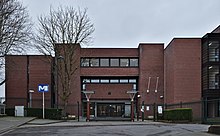Brussels includes a Japanese community, most of whom live in the Auderghem district. Auderghem includes a Japanese international school serving the community, The Japanese School of Brussels.
Geography
As of 2004 the majority of Brussels' Japanese expatriate population lives in Auderghem. In 2005 there were 641 Japanese persons in Auderghem, making them the second largest foreign nationality and 2.017% of the commune's population. The presence of The Japanese School of Brussels in the Auderghem area has attracted Japanese families with school-aged children to the area around the school. One street was named avenue Nippone to commemorate the community.
As of 2013 Japanese live in Auderghem, Ixelles, Uccle, Watermael-Boitsfort, and Woluwe-Saint-Pierre.
Commerce
As of 2013 the Belgian Living Guide, published by the Parents and Teachers Association, lists a series of businesses catering to the Japanese that are mostly in the centre of the city, around Avenue Louise. Some of these businesses are in proximity to the Japanese school. The guide lists four Japanese supermarkets and ten Japanese restaurants.
Language
See also: Francization of BrusselsJapanese people generally encounter the French and English languages at work. All of the schooling options for Japanese national children provide French education, and Marie Conte-Helm, author of The Japanese and Europe: Economic and Cultural Encounters, wrote that "French language education thus becomes, to a greater or a lesser degree, a normal part" of the everyday lives in Japanese expatriates. Major Japanese companies such as Toyota subsidize costs of language lessons for employees and families. Conte-Helm wrote that "in the main" the wives "take up such opportunities" since they have an "arguably greater need" for daily life French proficiency. Conte-Helm wrote that in the business sectors and "to varying degrees, in daily life" the English language "serves well" since it is understood and may be used in different parts of Belgium.
Education

The Japanese School of Brussels, established in 1979 by the Nihonjinkai, is located in Auderghem. Conte-Helm wrote that the school "acts as a focal point for all local Japanese." The part-time Japanese school services are provided by The Japanese Saturday School of Brussels.
Most Japanese children in Brussels attend the Japanese school and international schools, and some attend French-language government schools. Specifically, as of 2012 most Japanese in elementary and junior high attend the Japanese school, and most high school-aged Japanese attend the International School of Brussels (ISB). Japanese companies subsidize the tuition of Japanese students at the ISB. Some high school-aged Japanese attend the French Lycee in Brussels and the St. John's International School in Waterloo.
Due to the prevalence of English as a second language among the Japanese people, the lack of influence of the Dutch language, the Japanese companies sponsoring the Japanese school, and the temporary nature of the Japanese presence, very few Japanese people attend Dutch-language government schools.
Transport
In 2012 several officials from Belgium, including King Philippe, asked All Nippon Airways (ANA) to re-establish flights between Brussels and Tokyo. In 2015 ANA resumed service to Brussels; since 2001 Brussels had lacked air service to Tokyo.
Institutions
The Nihonjinkai ASBL. (ベルギー日本人会 Berugī Nihonjinkai) in Brussels opened in 1966 with 100 members and in 1979 acquired a legal status. It administers the Japanese school, arranges seminars, and publishes specialist reports and a monthly newsletter. As of 2012 the club has 1,200 members.
The Parents and Teachers Association publishes a Japanese-language guide, the Belgian Living Guide, for Japanese expatriates.
Notable people
Further information: Category:Belgian people of Japanese descentSee also
References
- Conte-Helm, Marie. The Japanese and Europe: Economic and Cultural Encounters (Bloomsbury Academic Collections). A&C Black, 17 December 2013. ISBN 1780939809, 9781780939803.
- Pang, Ching Lin (彭靜蓮, Pinyin: Péng Jìnglián). Negotiating Identity In Contemporary Japan: The Case of Kikokushijo. Routledge, October 2, 2012. ISBN 1136178120, 9781136178122.
- Pang, Ching Lin (Catholic University of Leuven Department of Anthropology). "Controlled internationalization: The case of kikokushijo from Belgium." International Journal of Educational Research. Volume 23, Issue 1, 1995, Pages 45–56. Available online 20 January 2000. DOI 10.1016/0883-0355(95)93534-3.
Notes
- State, Paul F. Historical Dictionary of Brussels. Scarecrow Press, July 27, 2004. ISBN 0810865556, 9780810865556. p. 21.
- ^ H. P. P. "320 élèves japonais à Auderghem" (Archive). La Dernière Heure. Sunday 1 May 2005. Retrieved on 11 January 2015.
- ^ Conte-Helm, p. 104.
- ^ Conte-Helm, p. 105.
- "欧州の補習授業校一覧(平成25年4月15日現在)" (Archive). Ministry of Education, Culture, Sports, Science and Technology (MEXT). Retrieved on May 10, 2014.
- Pang, Negotiating Identity In Contemporary Japan, p. 249.
- Pang, "Controlled internationalization: The case of kikokushijo from Belgium," p. 51.
- ^ Pang, "Controlled internationalization: The case of kikokushijo from Belgium," p. 50. "It is clear that in such a complex linguistic context, the majority of Japanese youngsters, whose parents came as a prolonged-stay expatriates, do not attempt to enter local Belgian schools. Given the temporary nature of their stay in Belgium, the comparatively insignificance of Dutch as an international language, the fact that English is the second language of the Japanese, and given the widely recognized structures of Japan’s overseas education (cfr.infra) provided by the Monbusho and the willingness of Japanese companies to share partially the financial burden, children of school age 6-15 attend the Japanese School."
- "La Belgique souhaite le rétablissement d'une liaison aérienne directe Bruxelles-Tokyo". Le Soir. 2012-06-11. Retrieved 2016-09-27.
- "Bruxelles-Tokyo: nouvelle liaison aérienne". Le Soir. 2015-07-01. Archived from the original on 2016-09-27. Retrieved 2016-09-27.
{{cite news}}: CS1 maint: bot: original URL status unknown (link) ()
External links
- Nihonjinkai a.s.b.l. (in Japanese)
- English information Archived 2014-01-09 at the Wayback Machine
- Embassy of Japan in Belgium
- Embassy of Japan in Belgium (in Japanese)
| Japanese diaspora | |||||||
|---|---|---|---|---|---|---|---|
| Africa | |||||||
| Americas |
| ||||||
| Asia | |||||||
| Europe | |||||||
| Oceania |
| ||||||
| Related articles |
| ||||||